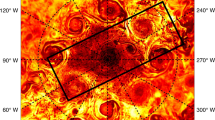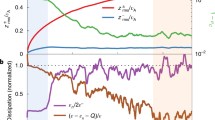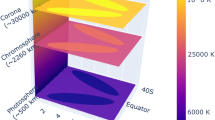Abstract
The structure of a sunspot is determined by the local interaction between magnetic fields and convection near the Sun's surface1,2. The dark central umbra is surrounded by a filamentary penumbra, whose complicated fine structure has only recently been revealed by high-resolution observations3,4,5,6,7,8,9,10,11,12,13,14. The penumbral magnetic field has an intricate and unexpected interlocking-comb structure and some field lines, with associated outflows of gas15, dive back down below the solar surface at the outer edge of the spot. These field lines might be expected to float quickly back to the surface because of magnetic buoyancy, but they remain submerged. Here we show that the field lines are kept submerged outside the spot by turbulent, compressible convection, which is dominated by strong, coherent, descending plumes16,17. Moreover, this downward pumping of magnetic flux explains the origin of the interlocking-comb structure of the penumbral magnetic field, and the behaviour of other magnetic features near the sunspot.
This is a preview of subscription content, access via your institution
Access options
Subscribe to this journal
Receive 51 print issues and online access
$199.00 per year
only $3.90 per issue
Buy this article
- Purchase on Springer Link
- Instant access to full article PDF
Prices may be subject to local taxes which are calculated during checkout





Similar content being viewed by others
References
Thomas, J. H. & Weiss, N. O. (eds) Sunspots: Theory and Observations NATO ASI C 375 (Kluwer, Dordrecht, 1992)
Schmieder, B., del Toro Iniesta, J. C. & Vázquez, M. (eds) Advances in the Physics of Sunspots Astronomical Society of the Pacific Conference Series 118, (San Francisco, 1997)
Degenhardt, D. & Wiehr, E. Spatial variation of the magnetic field inclination in a sunspot penumbra. Astron. Astrophys. 252, 821–826 (1991)
Solanki, S. K. & Montavon, C. A. P. Uncombed fields as the source of broad-band circular polarization of sunspots. Astron. Astrophys. 275, 283–292 (1993)
Title, A. M. et al. On the magnetic and velocity field geometry of simple sunspots. Astrophys. J. 403, 780–796 (1993)
Lites, B. W., Elmore, D. F., Seagraves, P. & Skumanich, A. Stokes profile analysis and vector magnetic fields. VI. Fine-scale structure of a sunspot. Astrophys. J. 418, 928–942 (1993)
Solanki, S. K., Montavon, C. A. P. & Livingston, W. Infrared lines as a probe of solar magnetic features. VII. On the nature of the Evershed effect in sunspots. Astron. Astrophys. 283, 221–231 (1994)
Rimmele, T. R. Sun center observations of the Evershed effect. Astrophys. J. 445, 511–516 (1995)
Stanchfield, D. C. H. II, Thomas, J. H. & Lites, B. W. The vector magnetic field, Evershed flow, and intensity in a sunspot. Astrophys. J. 477, 485–494 (1997)
Westendorp Plaza, C. et al. Evidence for a downward mass flux in the penumbral region of a sunspot. Nature 389, 47–49 (1997)
Rüedi, I., Solanki, S. K. & Keller, C. U. Infrared lines as probes of solar magnetic features. XV. Evershed flow in cool, weak penumbral fields. Astron. Astrophys. 348, L37–L40 (1999)
Schlichenmaier, R. & Schmidt, W. Flow geometry in a sunspot penumbra. Astron. Astrophys. 358, 1122–1132 (2000)
Martínez Pillet, V. Spectral signature of uncombed magnetic fields. Astron. Astrophys. 361, 734–742 (2000)
Westendorp Plaza, C., del Toro Iniesta, J. C., Ruiz Cobo, B. & Martínez Pillet, V. Optical tomography of a sunspot. III. Velocity stratification and the Evershed effect. Astrophys. J. 547, 1148–1158 (2001)
Montesinos, B. & Thomas, J. H. The Evershed effect in sunspots as a siphon flow along a magnetic flux tube. Nature 390, 485–487 (1997)
Stein, R. F. & Nordlund, Å. Simulations of solar granulation. I. General properties. Astrophys. J. 499, 914–933 (1998)
Brummell, N. H., Clune, T. L. & Toomre, J. Penetration and overshooting in turbulent compressible convection. Astrophys. J. 570, 825–854 (2002)
Tobias, S. M., Brummell, N. H., Clune, T. L. & Toomre, J. Transport and storage of magnetic field by overshooting turbulent compressible convection. Astrophys. J. 549, 1183–1203 (2001)
Nordlund, Å. et al. Dynamo action in stratified convection with overshoot. Astrophys. J. 392, 647–652 (1992)
Brandenburg, A. et al. Magnetic structures in a dynamo simulation. J. Fluid Mech. 306, 325–352 (1996)
Tobias, S. M., Brummell, N. H., Clune, T. L. & Toomre, J. Pumping of magnetic fields by turbulent penetrative convection. Astrophys. J. 502, L177–L180 (1998)
Dorch, S. B. F. & Nordlund, Å. On the transport of magnetic fields by solar-like stratified convection. Astron. Astrophys. 365, 562–570 (2001)
Rucklidge, A. M., Schmidt, H. U. & Weiss, N. O. The abrupt development of penumbrae in sunspots. Mon. Not. R. Astron. Soc. 273, 491–498 (1995)
Schlichenmaier, R., Jahn, K. & Schmidt, H. U. A dynamical model for the penumbral fine structure and the Evershed effect in sunspots. Astrophys. J. 493, L121–L124 (1998)
Tildesley, M. J. On the origin of filamentary structure in sunspot penumbrae: Linear instabilities. Mon. Not. R. Astron. Soc. (submitted)
Shine, R. A. & Title, A. M. in Encyclopedia of Astronomy and Astrophysics 3209–3212 (Nature Publishing Group, London, and Institute of Physics Publishing, Bristol, 2001)
Harvey, J. & Harvey, K. Observations of moving magnetic features near sunspots. Sol. Phys. 28, 61–71 (1973)
Acknowledgements
We thank J. Kuwabara and Y. Uchida for assistance in producing Fig. 3. This work was supported by the UK Particle Physics and Astrophysics Research Council (J.H.T. and N.O.W.), the Sun-Earth Connection Theory programme of the US National Aeronautics and Space Administration (N.H.B. and S.M.T.), and the Nuffield Foundation (S.M.T.).
Author information
Authors and Affiliations
Corresponding author
Ethics declarations
Competing interests
The authors declare that they have no competing financial interests.
Rights and permissions
About this article
Cite this article
Thomas, J., Weiss, N., Tobias, S. et al. Downward pumping of magnetic flux as the cause of filamentary structures in sunspot penumbrae. Nature 420, 390–393 (2002). https://doi.org/10.1038/nature01174
Received:
Accepted:
Issue Date:
DOI: https://doi.org/10.1038/nature01174
This article is cited by
-
Analysis of photospheric magnetic fields in AR 12546: a case study
Astrophysics and Space Science (2023)
-
Statistical Analysis of Asymmetric Sunspot Decay Observed by Hinode
Solar Physics (2020)
-
Evolution of Active Regions
Living Reviews in Solar Physics (2015)
-
Sunspot Bright Points
Solar Physics (2013)
-
Modeling the Subsurface Structure of Sunspots
Solar Physics (2010)
Comments
By submitting a comment you agree to abide by our Terms and Community Guidelines. If you find something abusive or that does not comply with our terms or guidelines please flag it as inappropriate.



